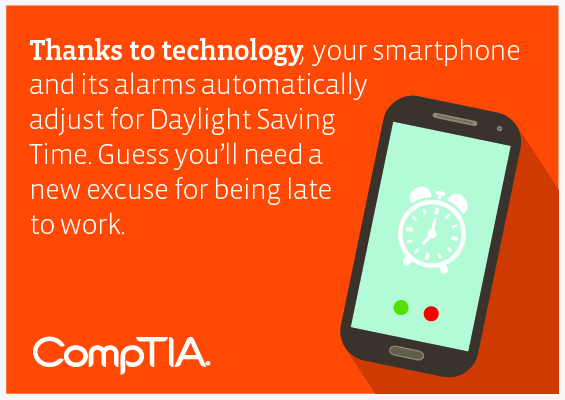 Who remembers marking daylight saving time (DST) on your calendar so you could walk around the house before you went to bed and reset the clocks on your stove, microwave, VCR and alarms? Today, many of those clocks have been replaced by smart devices – and manually adjusting your clocks is quickly becoming a thing of the past. But, how does it all happen? And, can you peacefully go to bed on the eve of DST without the worry that you’ll be late for work in the morning?
Who remembers marking daylight saving time (DST) on your calendar so you could walk around the house before you went to bed and reset the clocks on your stove, microwave, VCR and alarms? Today, many of those clocks have been replaced by smart devices – and manually adjusting your clocks is quickly becoming a thing of the past. But, how does it all happen? And, can you peacefully go to bed on the eve of DST without the worry that you’ll be late for work in the morning?
The History of Time
Before we can begin to contemplate how our smartphones automatically calibrate the correct time, we need a brief history lesson. Once upon a time, the Egyptians counted time by simply dividing daylight into 12 hours. It wasn’t an exact science, but it was close enough. In 1665, the public pendulum clock was invented – it’s accuracy precise enough to display hours, but not yet minutes. By 1927, quartz clocks could tell the time to about a half-a-second per day. A few decades later, in 1948, we had the first atomic clock, and by 1960, the even more accurate hydrogen master clock. But who determines the exact time? Well, that’s a job shared by the U.S. Naval Observatory (USNO) and the National Institute of Standards and Technology (NIST).
The Clocks That Control Everything
There are actually two clocks that control our time – the USNO Master Clock operates military time standards, and NIST operates on Coordinated Universal Time (UTC) to set U.S. civilian time standards. These two clocks provide the official U.S. government time. If you thought the phrase “it’s like clockwork” means simple – keeping the correct time is actually very complicated. In fact, every now and then, a leap second is added to UTC to synchronize clocks worldwide with the Earth’s ever-slowing rotation. While interesting, the leap second discussion takes us on a very physics-oriented tangent. Those of you wishing to take a closer look can read more about that from the USNO.
The Rise of the Internet
Of course, most of us don’t notice a leap second. We operate daily in accordance with whatever time our iPhones, Androids and laptops tell us. These connected devices run on Network Time Protocol (NTP), which uses UTC to synchronize computer clock times to a millisecond, or even a fraction of a millisecond.
According to a survey of the NTP network, more than 175,000 hosts run NTP on the internet. NIST also offers an Internet Time Services (ITS) and an Automated Computer Time Services (ACTS) to set computer and other clocks via the internet or telephone lines – making the manual turn of the hour and minutes something that our children might never have to deal with.
Daylight Saving Time
On March 12, many of us will “lose” an hour of sleep as we spring forward, but there are places in the United States that don’t change their clocks. Hawaii, Arizona, American Samoa, Guam, Puerto Rico, the Virgin Islands and the Northern Mariana Islands do not observe Daylight Saving Time. One Google search of the term brings up a slew of articles debating the importance of daylight saving time, but that’s another article for another day! We just want to be sure our alarm will go off in the morning.
Your Smartphone
By default, smartphones are set to automatically update the time as it changes. It’s the same as when you travel from one time zone to another. Your phone is supposed to update after “checking in” with the cell towers (utilizing ACTS) in your immediate area, adjusting not only the time on your phone, but also your calendar appointments and alarms.
Your Laptop or Tablet
Computers have a real-time clock – a special hardware device containing a quartz crystal on the motherboard that maintains the time. The motherboard also has a small battery that powers the clock device even when you shut your computer down. In addition, computers connected to the internet query a time server like NTP for the current time.
Your Appliances
While smart appliances, like thermostats and home security systems controlled remotely by your phone or tablet, aren’t considered cutting edge anymore, the Internet of Things (IoT) has made its way into your kitchen. In January, Whirlpool announced the Smart Home Lineup, including a suite of kitchen and laundry appliances that can be controlled via app. These WiFi-connected appliances will reset themselves for DST!
Your Vehicle
Today’s cars have the ability to parallel park themselves, prevent accidents and even drive themselves. So why do we still have to set the clock? This is one trend that is slow to catch on. In order for a clock to automatically adjust, it has to be connected to a GPS system or an embedded phone. Currently, the average vehicle on the road is about 10 years old. Auto industry insiders say that we’re at least five years away from automated clocks being a standard feature. If you need help setting your car clock, check out this handy guide.
So, on the night of March 11th, you may have fewer clocks that you need to set forward one hour before you go to bed. As we move into an era that reminds us more and more of “The Jetsons,” keep in mind that while some of the conveniences of technology may make our lives easier, there are elements of humanity that make them worthwhile.

